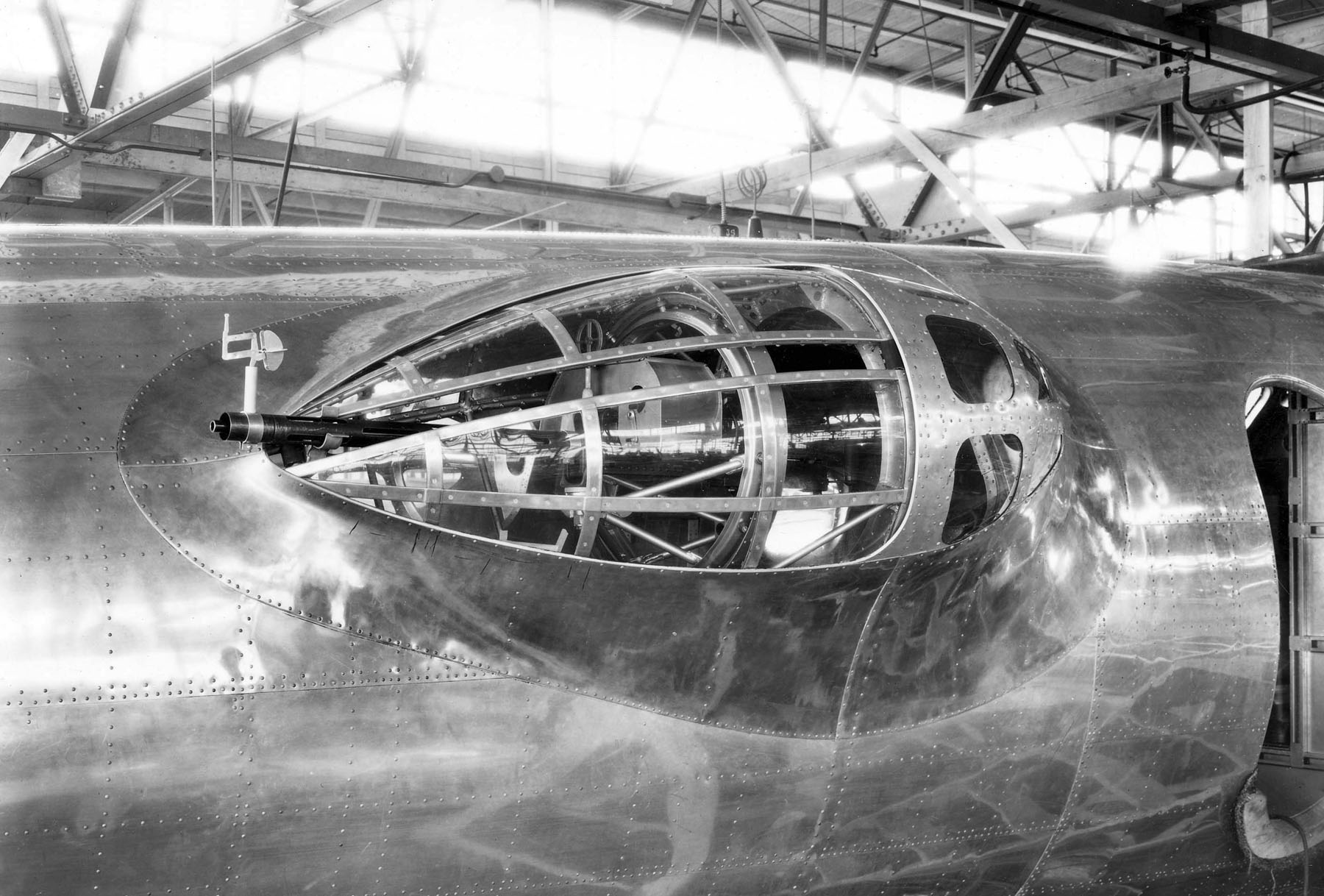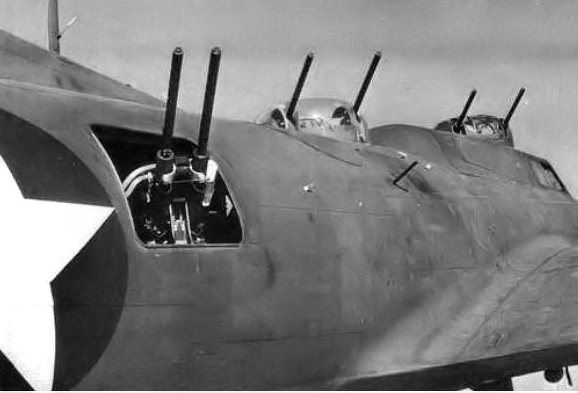|
B-17
The Boeing B-17 Flying Fortress is an American four-engined heavy bomber aircraft developed in the 1930s for the United States Army Air Corps (USAAC). A fast and high-flying bomber, the B-17 dropped more bombs than any other aircraft during World War II, used primarily in the European Theater of Operations. It is the third-most produced bomber in history, behind the American four-engined Consolidated B-24 Liberator and the German multirole, twin-engined Junkers Ju 88. The B-17 was also employed in transport, anti-submarine warfare, and search and rescue roles. In a USAAC competition, Boeing's prototype Model 299/XB-17 outperformed two other entries but crashed, losing the initial 200-bomber contract to the Douglas B-18 Bolo. Still, the Air Corps ordered 13 more B-17s for further evaluation, which were introduced into service in 1938. The B-17 evolved through numerous design advances but from its inception, the USAAC (from 1941 the United States Army Air Forces, USAAF) pro ... [...More Info...] [...Related Items...] OR: [Wikipedia] [Google] [Baidu] |
Boeing B-17 Flying Fortress Variants
The following is an extensive catalogue of the variants and specific unique elements of each variant and/or design stage of the Boeing B-17 Flying Fortress, a heavy bomber used by the United States Army Air Forces and other Allies of World War II, Allied air forces during World War II. Boeing Model 299 (B-17) The Model 299 was the original aircraft built by Boeing to fulfill an August 1934 requirement by the United States Army Air Corps for a bomber capable of carrying of bombs at .Hess & Winchester ''Wings of Fame'' No. 6, 1997, p. 41. The 299 was powered by four Pratt & Whitney R-1690 Hornet, Pratt & Whitney S1EG Hornet radial engines, giving a maximum speed of and a maximum gross weight of . It carried a bomb load of up to eight bombs, with a defensive armament of five machine guns, with one in a nose turret and one each in dorsal and ventral mounts and two in waist blisters.Bowers 1989, pp. 291–292.Hess & Winchester ''Wings of Fame'' No. 6, 1997, pp. 41–42. In 19 ... [...More Info...] [...Related Items...] OR: [Wikipedia] [Google] [Baidu] |
List Of Surviving Boeing B-17 Flying Fortresses
The Boeing B-17 Flying Fortress is an American four-engine heavy bomber used by the United States Army Air Forces and other Allies of World War II, Allied air forces during World War II. Forty-five planes survive in complete form, including 38 in the United States with many preserved in museum displays. The number of operational B-17s has dwindled over time, but there are still several in flying condition. Of the 12,731 B-17s built, about 4,735 were lost during the war. After the war, planes that had flown in combat missions were sent for scrapping at Aircraft boneyard, boneyards, such as those at Marine Corps Air Facility Walnut Ridge, Walnut Ridge and Kingman Airport (Arizona), Kingman. Consequently, only six planes that survive today have seen combat. Most of the other survivors were built too late to see active service and then were used through the 1950s and 1960s in military and civilian capacities. Many are painted to represent actual planes that flew in combat. Survivi ... [...More Info...] [...Related Items...] OR: [Wikipedia] [Google] [Baidu] |
Boeing YB-40 Flying Fortress
The Boeing YB-40 Flying Fortress was a modification for operational testing purposes of the B-17 Flying Fortress bomber aircraft, converted to act as a heavily armed gunship to support other bombers during World War II. At the time of its development, long-range fighter aircraft such as the North American P-51 Mustang were just entering quantity production, and thus were not yet available to accompany bombers all the way from England to Germany and back. Design and development Work on the prototype, Project V-139, began in September 1942 by converting the second production B-17F-1-BO (serial number 41-24341) built. Conversion work was done by Lockheed's Vega company. The aircraft differed from the standard B-17 in that a second manned dorsal turret was installed in the former radio compartment, just behind the bomb bay and forward of the ventral ball turret's location. The single .50-caliber light-barrel (12.7 mm) Browning machine gun at each waist station was replace ... [...More Info...] [...Related Items...] OR: [Wikipedia] [Google] [Baidu] |
Boeing C-108 Flying Fortress
The Boeing C-108 Flying Fortress was an American transport aircraft used during World War II. Four were converted from B-17 Flying Fortress heavy bombers. Design and development The first C-108 built (designated XC-108) was a B-17E (''41-2593'') converted to a V.I.P. transport for General Douglas MacArthur in 1943. With the exception of the nose and tail turrets, all armament was removed, as was all armor. The interior of the plane was made into a flying office for MacArthur, with extra windows, cooking facilities, and living space. To facilitate entry and exit, a drop-down door with steps was installed in the rear fuselage. A similar conversion was later made on a B-17F-40-VE (''42-6036''), which was redesignated YC-108. Between August 1943 and March 1944, another B-17E (''41-2595'') was converted to a cargo aircraft and designated XC-108A. Hoping to convert obsolete bombers into cargo aircraft, the United States Army Air Forces initiated a remanufacturing station at Wri ... [...More Info...] [...Related Items...] OR: [Wikipedia] [Google] [Baidu] |
United States Army Air Corps
The United States Army Air Corps (USAAC) was the aerial warfare service component of the United States Army between 1926 and 1941. After World War I, as early aviation became an increasingly important part of modern warfare, a philosophical rift developed between more traditional ground-based army personnel and those who felt that aircraft were being underutilized and that air operations were being stifled for political reasons unrelated to their effectiveness. The USAAC was renamed from the earlier United States Army Air Service on 2 July 1926, and was part of the larger United States Army. The Air Corps became the United States Army Air Forces (USAAF) on 20 June 1941, giving it greater autonomy from the Army's middle-level command structure. During World War II, although not an administrative echelon, the Air Corps (AC) remained as one of the combat arms of the Army until 1947, when it was legally abolished by legislation establishing the United States Department of the Air Fo ... [...More Info...] [...Related Items...] OR: [Wikipedia] [Google] [Baidu] |
The Swoose
''The Swoose'' is a Boeing B-17 Flying Fortress, Boeing B-17D-BO Flying Fortress, USAAF serial number 40-3097, that saw extensive use in the Southwest Pacific theatre of World War II and survived to become the oldest B-17 still intact. It is the only early "shark fin"-tailed B-17 known to exist, and the only surviving B-17 to have seen action in the 1941–42 Philippines campaign (1941–1942), Philippines Campaign, operating on the first day of the United States' entry into the war. After that campaign it ended up in Australia and used for VIP duties until it fell out of service. After the war it was rescued from being scrapped, eventually making its way into the hands of the National Museum of the Air Force, where in the 21st century it is being restored for display. Early history The 38th of 42 B-17Ds built by Boeing, "40-3097" was accepted by the United States Army Air Corps, Army Air Corps on 25 April 1941 in Seattle, Washington. It was ferried to Hickam Field, Hawaii, 1 ... [...More Info...] [...Related Items...] OR: [Wikipedia] [Google] [Baidu] |
Boeing 307 Stratoliner
The Boeing Model 307 Stratoliner (or Strato-Clipper in Pan American Airways, Pan American service, or C-75 in United States Army Air Forces, USAAF service) is an American stressed-skin four-engine low-wing Conventional landing gear, tailwheel monoplane airliner derived from the Boeing B-17 Flying Fortress, B-17 Flying Fortress bomber, which entered commercial service in July 1940. It was the first airliner in revenue service with a Cabin pressurization, pressurized cabin, which with supercharged engines, allowed it to cruise above the weather. As such it represented a major advance over contemporaries, with a cruising speed of at compared to the Douglas DC-3's , at then in service.Davies, 2000, p.52 When it entered commercial service it had a crew of five to six, including two pilots, a flight engineer, two flight attendants and an optional navigator, and had a capacity for 33 passengers, which later modifications increased, first to 38, and eventually to 60. Development In ... [...More Info...] [...Related Items...] OR: [Wikipedia] [Google] [Baidu] |
Sentimental Journey (aircraft)
''Sentimental Journey'' (44-83514) is the nickname of a Boeing B-17 Flying Fortress, B-17G Flying Fortress bomber. It is based at the Commemorative Air Force Museum in Mesa, Arizona, Mesa, Arizona, US."B-17s: Where to find them." ''aerovintage.com'', 15 January 2007. The aircraft is regularly flown to airshows throughout North America. The nose art features Betty Grable, the number one pinup girl of the World War II era. The aircraft's name takes after a Sentimental Journey (song), song made very popular by Doris Day in 1945. 
History Boeing B-17G 44-83514 was built by Dou ...[...More Info...] [...Related Items...] OR: [Wikipedia] [Google] [Baidu] |
Consolidated B-24 Liberator
The Consolidated B-24 Liberator is an American heavy bomber, designed by Consolidated Aircraft of San Diego, California. It was known within the company as the Model 32, and some initial production aircraft were laid down as export models designated as various LB-30s, in the Land Bomber design category. At its inception, the B-24 was a modern design featuring a highly efficient shoulder-mounted, high aspect ratio Davis wing. The wing gave the Liberator a high cruise speed, long Range (aeronautics), range and the ability to carry a heavy Aerial bomb, bomb load. In comparison with its contemporaries, the B-24 was relatively difficult to fly and had poor low-speed performance; it also had a lower Ceiling (aeronautics), ceiling and was less robust than the Boeing B-17 Flying Fortress. While Aircrew#Military, aircrews tended to prefer the B-17, General Staff favored the B-24 and procured it in huge numbers for a wide variety of roles. At approximately 18,500 units – including 8,68 ... [...More Info...] [...Related Items...] OR: [Wikipedia] [Google] [Baidu] |
United States Army Air Forces
The United States Army Air Forces (USAAF or AAF) was the major land-based aerial warfare service component of the United States Army and ''de facto'' aerial warfare service branch of the United States during and immediately after World War II (1941–1947). It was created on 20 June 1941 as successor to the previous United States Army Air Corps and is the direct predecessor of the United States Air Force, today one of the six United States Armed Forces, armed forces of the United States. The AAF was a component of the United States Army, which on 2 March 1942 was divided functionally by executive order into three autonomous forces: the Army Ground Forces, the United States Army Services of Supply (which in 1943 became the Army Service Forces), and the Army Air Forces. Each of these forces had a commanding general who reported directly to the Chief of Staff of the United States Army, Army Chief of Staff. The AAF administered all parts of military aviation formerly distributed am ... [...More Info...] [...Related Items...] OR: [Wikipedia] [Google] [Baidu] |
Boeing XB-38 Flying Fortress
The XB-38 Flying Fortress was a single example conversion of a production B-17E Flying Fortress, testing whether the Allison V-1710 V type engine could be substituted for the standard Wright R-1820 radial engine during early World War II. Design and development The XB-38 was the result of a modification project undertaken by Vega (a subsidiary of Lockheed) on a Boeing B-17 Flying Fortress to fit it with liquid-cooled Allison V-1710-89 V-12 engines. It was to be an improved B-17, and an alternative if the normally fitted air-cooled Wright R-1820 radial engines became scarce. Completing the modifications took less than a year, and the XB-38 made its first flight on May 19, 1943. Only one was built, and it was modified from a regular production aircraft. The XB-38 delivered a higher top speed, but its ceiling was lower. After a few flights it was grounded due to exhaust gas leaks from the engine manifolds. Once this had been fixed, testing resumed until the ninth flight on June 1 ... [...More Info...] [...Related Items...] OR: [Wikipedia] [Google] [Baidu] |
Heavy Bomber
Heavy bombers are bomber Fixed-wing aircraft, aircraft capable of delivering the largest payload of air-to-ground weaponry (usually Aerial bomb, bombs) and longest range (aeronautics), range (takeoff to landing) of their era. Archetypal heavy bombers have therefore usually been among the largest and most powerful Military aviation, military aircraft at any point in time. In the second half of the 20th century, heavy bombers were largely superseded by strategic bombers, which were often even larger in size, had much longer ranges and were capable of delivering nuclear bombs. Because of advances in Aerospace engineering, aircraft design and engineering — especially in Aircraft engine, powerplants and aerodynamics — the size of payloads carried by heavy bombers has increased at rates greater than increases in the size of their airframes. The largest bombers of World War I, the ''Riesenflugzeuge'' of Germany, could carry a payload of up to of bombs; by the latter half of World ... [...More Info...] [...Related Items...] OR: [Wikipedia] [Google] [Baidu] |










